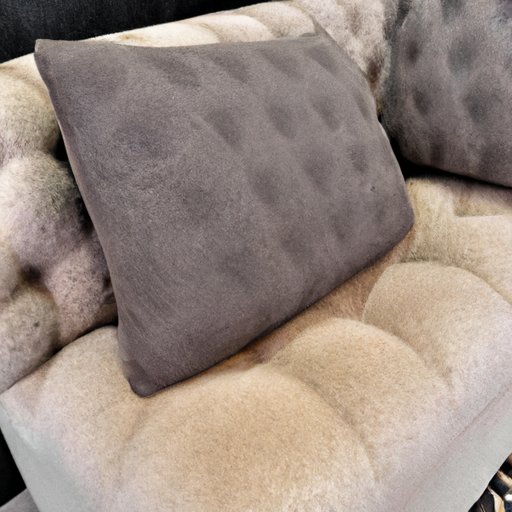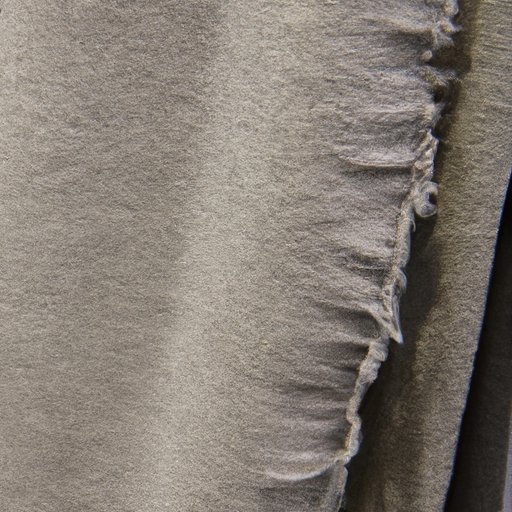Introduction
Texture is a key element of interior design. It plays a vital role in creating a certain atmosphere in any room, as well as helping to tie together the overall aesthetic of a home. But what exactly is texture in interior design?
Texture in interior design refers to the physical qualities of a surface, such as its smoothness, roughness, pattern, or visual appearance. It can be used to create a sense of warmth and coziness, as well as add visual interest to a space. In this article, we’ll explore the different types of texture in interior design, how to use them to create a cohesive look, and tips for combining textures to create a unique style.
Exploring the Different Types of Texture in Interior Design
When it comes to texture in interior design, there are four main types: smooth textures, rough textures, textural patterns, and visual textures.
Smooth Textures
Smooth textures are usually created with materials such as glass, metal, lacquer, and polished stone. They can give a room a modern, sleek look that is both sophisticated and timeless. Smooth textures can also be used to create a sense of calm in a space, especially when combined with neutral colors.
Rough Textures
Rough textures are typically created with materials such as wood, brick, stone, and concrete. These materials can give a room a rustic, earthy feel that is both cozy and inviting. Rough textures can also be used to create a sense of warmth and comfort in a space, especially when combined with warm colors.
Textural Patterns
Textural patterns are created by combining different materials and textures to create a unique design. Examples include herringbone, chevron, and basket-weave patterns. Textural patterns can be used to add visual interest to a space and create a sense of movement. They can also be used to make a room appear larger by drawing the eye up and down.
Visual Textures
Visual textures are created with fabrics, rugs, wallpapers, and other soft furnishings. They can be used to add warmth and texture to a space, as well as create a sense of depth and dimension. Visual textures can also be used to bring a room to life and make it more inviting.

How to Use Texture in Interior Design to Create a Cohesive Look
Using texture in interior design is a great way to create a cohesive look in your home. Here are some tips for incorporating different textures into each room:
Incorporate Different Textures into Each Room
When using texture in interior design, it’s important to incorporate different textures into each room. This will help create balance and harmony throughout your home. For example, you could use a combination of smooth and rough textures in your living room, or mix and match textured fabrics in your bedroom.
Establish a Color Palette
When working with texture, it’s also important to establish a color palette. Choose a few colors that complement each other and then choose textures that work within that palette. This will help create a cohesive look throughout your home.
Work with Existing Furniture and Accessories
When using texture in interior design, it’s also important to work with existing furniture and accessories. Incorporate textures that complement the existing pieces in the room. This will help create a unified look and make the space feel more cohesive.
The Power of Texture in Interior Design: Tips for Creating Visual Interest
Texture can be used to create visual interest in a room. Here are some tips for making the most of texture in interior design:
Contrasting Textures
Using contrasting textures is one of the best ways to create visual interest in a room. For example, pairing a smooth texture like glass with a rough texture like wood can create an interesting juxtaposition that will draw the eye. You can also use contrasting textures to emphasize certain areas or features in a room.
Combining Textures
Combining different textures is another great way to create visual interest. Try combining smooth and rough textures, or mixing textured fabrics with textured patterns. The possibilities are endless!
Play with Scale
Texture can also be used to play with scale. By incorporating larger and smaller textures into a room, you can create a sense of depth and dimension. This is especially effective when used to highlight certain areas or features in a room.

The Role of Texture in Achieving a Luxurious Home Interior
Texture can be used to create a luxurious home interior. Here are some tips for incorporating texture into your decor:
Incorporate Natural Elements
Incorporating natural elements into your decor is one of the best ways to achieve a luxurious look. Natural elements such as wood, stone, leather, and wool can all be used to add texture and warmth to a room. They can also be used to create a sense of sophistication and luxury.
Choose Quality Fabrics
Choosing quality fabrics is another great way to achieve a luxurious look. Invest in high-quality fabrics such as silk, velvet, linen, and cashmere. These fabrics are soft to the touch and will add texture and richness to any room.
Invest in Statement Pieces
Investing in statement pieces is also key to creating a luxurious home interior. Choose pieces that are made from quality materials and feature interesting textures. These pieces will add visual interest and make a room feel more luxurious.
How to Incorporate Texture into Your Home Decor
When incorporating texture into your home decor, there are several things to consider. Here are some tips for adding texture to your space:
Start with Walls
When adding texture to your home decor, start with the walls. Wallpaper, tile, and even paint can be used to add texture to a room. Experiment with different patterns and textures to find the right look for your space.
Layer Fabrics
Adding layers of fabric is another great way to add texture to a room. Layer different fabrics such as linen, velvet, and fur to create a cozy and inviting atmosphere. You can also use fabrics to add color and pattern to a room.
Accessorize with Texture
Finally, accessorizing with texture can make a big difference. Adding pillows, throws, rugs, and other accessories can help bring a room to life and add texture to any space.

Combining Textures to Create a Unique Interior Design Style
When combining textures to create a unique interior design style, it’s important to keep a few things in mind. Here are some tips for making the most of texture in your home:
Mix and Match Textures
Mixing and matching different textures is key to creating a unique interior design style. Try combining smooth and rough textures, or mixing textured fabrics with textured patterns. The possibilities are endless!
Introduce Unexpected Elements
Introducing unexpected elements is another great way to create a unique interior design style. Consider incorporating unexpected elements such as mirrors, metallic accents, and bold colors to add visual interest and create a unique look.
Balance Light and Dark Tones
When combining textures, it’s also important to balance light and dark tones. Using a mix of light and dark colors, as well as different textures, will help create a cohesive look that is both visually appealing and unique.
Conclusion
Texture plays an important role in interior design. It can be used to create a sense of warmth and coziness, as well as add visual interest to a space. There are four main types of texture in interior design: smooth textures, rough textures, textural patterns, and visual textures. When using texture in interior design, it’s important to incorporate different textures into each room, establish a color palette, and work with existing furniture and accessories. Texture can also be used to create visual interest in a room by contrasting textures, combining textures, and playing with scale. Finally, texture can be used to create a luxurious home interior by incorporating natural elements, choosing quality fabrics, and investing in statement pieces.
By following these tips, you can create a unique interior design style that incorporates texture in a thoughtful and creative way. With a little bit of creativity, you can turn any room into a beautiful and inviting space.
(Note: Is this article not meeting your expectations? Do you have knowledge or insights to share? Unlock new opportunities and expand your reach by joining our authors team. Click Registration to join us and share your expertise with our readers.)
